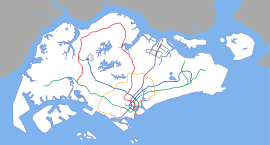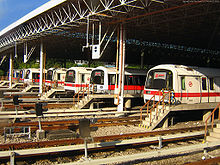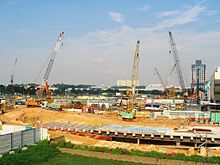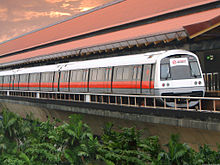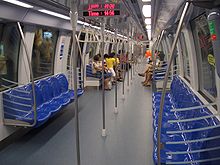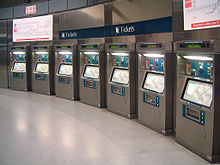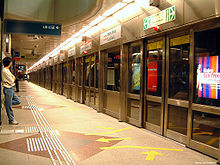- Mass Rapid Transit (Singapore)
-
Mass Rapid Transit (MRT)
大众快速交通 (地铁)
Sistem Pengangkutan Gerak Cepat
துரிதக் கடவு ரயில்
Info Owner Land Transport Authority Locale Singapore Transit type Rapid transit Number of lines 4 Daily ridership 2.224 million (September 2011)[1] Operation Began operation 7 November 1987 Operator(s) SMRT Corporation
SBS TransitTechnical Track gauge 1,435 mm (4 ft 8 1⁄2 in) Standard gauge The Mass Rapid Transit or MRT is a rapid transit system that forms the backbone of the railway system in Singapore, spanning the entire city-state. The initial section of the MRT, between Yio Chu Kang Station and Toa Payoh Station, opened in 1987 establishing itself as the second-oldest metro system in Southeast Asia, after Manila's LRT System. The network has since grown rapidly as a result of Singapore's aim of developing a comprehensive rail network as the main backbone of the public transport system in Singapore with an average daily ridership of 2.069 million in 2010, nearly 65% of the bus network's 3.199 million in the same period.[2]
The MRT has 89 operational stations[3] with 146.5 kilometres of lines and operates on standard gauge. The rail lines have been constructed by the Land Transport Authority, a statutory board of the Government of Singapore, which allocates operating concessions to the profit-based corporations SMRT Corporation and SBS Transit. These operators also run bus and taxi services, thus ensuring that there is a full integration of public transport services. The MRT is complemented by the regional Light Rail Transit (LRT) systems that link MRT stations with HDB public housing estates.[4] Services operate from about 5:30 am and usually end before 1 a.m. daily with frequencies of approximately three to eight minutes, and services extended during festive periods such as Chinese New Year and Christmas.[5]
Contents
History
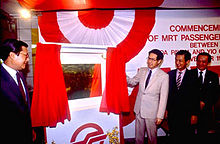 Deputy Prime Minister Ong Teng Cheong opening the initial section of the MRT at Toa Payoh Station, 7 November 1987.
Deputy Prime Minister Ong Teng Cheong opening the initial section of the MRT at Toa Payoh Station, 7 November 1987. Main article: History of the Mass Rapid Transit (Singapore)
Main article: History of the Mass Rapid Transit (Singapore)The origins of the Mass Rapid Transit (MRT) are derived from a forecast by city planners in 1967 which stated the need for a rail-based urban transport system by 1992.[6][7] Following a debate on whether a bus-only system would be more cost-effective, the Parliament came to the conclusion that an all-bus system would be inadequate, since it would have to compete for road space in a land-scarce country.[8][9] The initial S$5 billion construction of the Mass Rapid Transit network was Singapore's largest public works project at the time, starting on 22 October 1983 at Shan Road.[10] The network was built in stages, with the North South Line given priority because it passed through the Central Area that has a high demand for public transport. The Mass Rapid Transit Corporation (MRTC), later renamed as SMRT Corporation — was established on 14 October 1983; it took over the roles and responsibilities of the former provisional Mass Rapid Transit Authority.[8] On 7 November 1987, the first section of the North South Line started operations, consisting of five stations over six kilometres.[10] Fifteen more stations were opened later, and the MRT system was officially launched on 12 March 1988 by Lee Kuan Yew, then Prime Minister of Singapore. Another 21 stations were subsequently added to the system; the opening of Boon Lay Station on the East West Line on 6 July 1990 marked the completion of the system two years ahead of schedule.[11][12]
The MRT has subsequently been expanded. This includes a S$1.2 billion expansion of the North South Line into Woodlands, completing a continuous loop on 10 February 1996.[13][14] The concept of having rail lines that bring people almost directly to their homes led to the introduction of the Light Rail Transit (LRT) lines connecting with the MRT network.[14][15] On 6 November 1999, the first LRT trains on the Bukit Panjang LRT went into operation.[16] In 2002, the Changi Airport and Expo stations were added to the MRT network.[17] The North East Line (NEL), the first line operated by SBS Transit, opened on 20 June 2003, one of the first fully automated heavy rail lines in the world. On 15 January 2006, after intense lobbying by the public, Buangkok station was opened.[18][19] The Boon Lay Extension, consisting of Pioneer and Joo Koon, began revenue service on 28 February 2009.[20][21] On 28 May 2009, the first section of the Circle Line from Marymount Station to Bartley Station was opened. The second sections, from Tai Seng Station to Dhoby Ghaut Station, opened on 17 April 2010.The third sections, from Caldecott stations to Harbourfront station, opened on 8 October 2011.
Infrastructure
Current network
September 2011 edition MRT System Map here having all Circle Line stations operational.
Line
(Operator)First section operational Stations Length
(km)Terminals Depot along line North South Line
(SMRT Trains)7 November 1987 25 44 Jurong East Marina Bay Bishan
Ulu PandanEast West Line
(SMRT Trains)12 December 1987 29 49.2 Pasir Ris Joo Koon Ulu Pandan
Changi10 January 2001 2 Tanah Merah Changi Airport North East Line
(SBS Transit)20 June 2003 16 20 HarbourFront Punggol Sengkang Circle Line
(SMRT Trains)28 May 2009 29 (1 not operational) 33.3 Dhoby Ghaut HarbourFront Kim Chuan Facilities and services
Main article: Facilities on the Mass Rapid Transit (Singapore)Except for the partly at-grade Bishan MRT Station, the entirety of the MRT is elevated or underground. Most underground stations are deep and hardened enough to withstand conventional aerial bomb attacks and to serve as bomb shelters.[22][23][24] Mobile phone service is available in and between all stations on the entire MRT network.[25] Underground stations and the trains are air-conditioned.
Every station is equipped with General Ticketing Machines (GTMs), a Passenger Service Centre, LED and plasma displays that show train service information and announcements. All stations are also equipped with restrooms and payphones, although some restrooms are located at street level.[26] Some stations, especially the major ones, have additional amenities and services, such as retail shops and kiosks, supermarkets, convenience stores such as 7-Eleven or Cheers, automatic teller machines, and self-service automated kiosks for a variety of services.[27] Heavy-duty escalators shuttle passengers up or down stations at a rate of 0.75 m/s, 50% faster than conventional escalators.[28][29]
The older stations on the North South Line and East West Line were not originally constructed with any accessible facilities, such as lifts, ramps, tactile guidance systems (Braille tactiles on the floor surface), wider fare gates and toilets for passengers with disabilities;[30] authorities in the past actively discouraged use of their system by the disabled.[31] However, these facilities are progressively installed as part of a program to make all stations accessible to the elderly and to those with disabilities.[30][32][33] All stations are now barrier-free, although works are still ongoing to provide stations with additional barrier-free facilities.
Depots
SMRT Corporation has four train depots: The Bishan Depot is the central maintenance depot with train overhaul facilities,[34] while the Changi Depot and Ulu Pandan Depot inspect and house trains overnight.[35] The underground Kim Chuan Depot houses trains for the Circle Line.[36] Jurong East Station, Tanah Merah Station, Ang Mo Kio Station, and Paya Lebar Station Circle Line Platforms were built with a third middle track for off-service trains to stop at before they return to their depots, but the first two are now used as terminals for the North South Line and the East West Line Changi Airport Extension respectively, and the last two are now used as terminals for the North South Line special train and the Circle Line special train respectively.
The Sengkang Depot houses trains for the North East Line, the Sengkang LRT and the Punggol LRT, all operated by SBS Transit. It is the first depot to have structural provisions for an industrial development located above the depot, to minimize the wastage of land in land-scarce Singapore.[36] .
Architecture and art
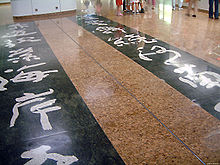 A Chinese calligraphy script by Tan Swie Hian, is integrated into the flooring of the Chinatown Station.
A Chinese calligraphy script by Tan Swie Hian, is integrated into the flooring of the Chinatown Station.
Early stages of the MRT's construction paid relatively scant attention to station design, with an emphasis on functionality over aesthetics. This is particularly evident in the first few stages of the North South Line and the East West Line that opened between 1987 and 1988 from Yio Chu Kang Station to Clementi Station. An exception to this was Orchard Station, chosen by its designers to be a "showpiece" of the system and was built initially with a domed roof.[37] Architectural themes became a more important issue only in subsequent stages, and resulted in such designs as the cylindrical station shapes on all stations between Kallang and Pasir Ris except Eunos, and west of Boon Lay and the perched roofs at Boon Lay, Bukit Batok, Bukit Gombak, Choa Chu Kang, Khatib and Yishun stations.[38]
Art pieces, where present, are seldom highlighted; they primarily consist of a few paintings or sculptures representing the recent past of Singapore, mounted in major stations. The opening of the Woodlands Extension introduced bolder pieces of artwork, such as a 4,000 kg sculpture in Woodlands Station.[39] With the opening of the North East Line, a series of artworks created under a programme called "The Art In Transit" were commissioned by the Land Transport Authority. Created by 19 local artists and integrated into the stations' interior architecture, these artworks aim to promote the appreciation of public art in high-traffic environments. The artwork for each station is designed to suit the station's identity. Only stations on the North East Line come under this programme. Circle Line will also feature the Art in Transit scheme.[40] An art contest was held by the authorities in preparation of a similar scheme to be implemented for the upcoming Circle Line.[41]
 Expo Station, sited adjacent to the 100,000 square metre Singapore Expo exhibition facility, sports a futuristic design by Foster and Partners.
Expo Station, sited adjacent to the 100,000 square metre Singapore Expo exhibition facility, sports a futuristic design by Foster and Partners.
Expo Station on the East West Line Changi Airport Extension is adjacent to the 100,000 square metre Singapore Expo exhibition facility. Designed by Foster and Partners and completed in January 2001, the station features a large pillarless titanium clad roof in an elliptical shape that sheathes the length of the station platform. This complements a smaller 40 metre reflective stainless steel disc overlapping the titanium ellipse and visually floats over a glass elevator shaft and the main entrance. The other station with similar architecture is Dover.[42][43]
Expansion
The MRT system had relied on its two main lines, namely the North South Line and East West Line, for more than a decade until the opening of the North East Line in 2003. While plans for these lines, as well as those currently under construction, were formulated long before, the Land Transport Authority's (LTA) publication of a white paper titled "A World Class Land Transport System" in 1996 galvanised the government's intentions to greatly expand on the existing system.[44][45] The plans allow for the long-term replacement of the bus network by rail-based transportation as the primary mode of public transportation. It called for the expansion of the 67 kilometres of track in 1995 to over 160 in 10 to 15 years, and envisaged further expansion in the longer term.[44] It was anticipated that daily ridership in 2020 would have grown to 4.6 million from the current 1.4 million passengers.[46] The addition of the lines currently under construction and those approved for construction will bring the MRT network to 278 km by 2020.[47][48]
Circle Line
The Circle Line (CCL) is a 35.7 kilometre line passing through 31 stations. The Circle Line connects all existing MRT lines radiating out of the city centre and allows commuters to bypass stations within the downtown area, thereby reducing congestion at the City Hall and Raffles Place interchange stations. The Circle Line will also connect to Marina South via a spur line branching off Promenade Station and ending at Marina Bay Station. 3-car trainsets will run on the Circle Line, in contrast to the 6-car trainsets running on the older lines.
Apart from the 28 stations currently in operation, Bayfront Station and Marina Bay Station will commence service in January 2012 while Bukit Brown Station will be constructed at a later date.
Downtown Line
Currently in various stages of planning and construction, the 42 kilometre fully underground Downtown Line (DTL) passing through 34 stations will connect the northwestern and eastern regions of Singapore to the new downtown at Marina Bay in the south and the Central Business District.[49] Similar to the Circle Line, 3-car trainsets will run on the Downtown Line with line capacity for 500,000 commuters daily. It will be completed in three stages with stages 1, 2 and 3 opening by 2013, 2015 and 2017 respectively.[46][50][51][52]
Thomson Line
The forthcoming 30-kilometre Thomson Line (TSL) is tentatively planned to serve 23 stations. The TSL will start from the Marina Bay area and end in the northern part of Singapore. En-route, the line will travel through the Central Business District, Ang Mo Kio, Sin Ming, Kebun Baru, Thomson, Kim Seng and Woodlands in the north.[46][53] It will relieve crowding on the North South Line and reduce travel times between Woodlands and the Central Business District. The underground line is expected to be completed by 2018.[46]
Eastern Region Line
The 21-kilometre Eastern Region Line (ERL) is tentatively planned to serve 12 stations. The ERL will start from the Marina Bay station and go east to Marina East, Tanjong Rhu, Siglap, Marine Parade and Bedok South before terminating further north at Changi.[46][53] It will generally be parallel to and south of the East West Line. It will relieve crowding on the East West Line. The underground line is expected to be completed by 2020.
Extensions to existing lines
The East West Line Tuas West Extension is a fully elevated westward extension from Joo Koon Station. The 7.5 kilometre extension includes 4 new stations and a depot located near the Tuas Checkpoint and is expected to be operational by 2016. The easternmost station along the Tuas West Extension will have 2 island platforms serving 4 tracks as it will be serving as an interchange station for the future 6 kilometre Tuas South Extension which will have 2 new stations.
The North South Line Marina South Extension is a fully underground southward extension from Marina Bay Station. The 1 kilometre extension includes 1 new station located near the upcoming International Cruise Centre at Marina South. This extension will commence passenger service by 2014, a year earlier than originally scheduled.
Rolling stock
Main articles: Kawasaki Heavy Industries C151, Siemens C651, Kawasaki Heavy Industries & Nippon Sharyo C751B, Alstom Metropolis C751A, Alstom Metropolis C830, Kawasaki Heavy Industries C151A, and Bombardier MOVIA C951Four types of rolling stock are used on the North South Line and the East West Line. They are powered by 750-volt DC third rail, operate in sets of six cars,[54][55][56] and use an automatic train operation system (ATO) that is similar to London Underground's Victoria Line.[56]
The majority of the fleet comprises 66 six car C151 trains;[57] these were the oldest trains in operation.[54] They were built between 1986 and 1989 by Kawasaki Heavy Industries in consortium with Nippon Sharyo, Tokyu Car Corporation and Kinki Sharyo for S$581.5 million.[54][58] A S$142.7 million refurbishment of these trains' interior were completed in 2009.[59][60] 19 more six car C651 trains, manufactured by Siemens in Vienna, were purchased in 1994 when the Woodlands extension opened.[61][62]
The French-manufactured Alstom Metropolis C830 are the newest rolling stock currently operating on the MRT network.
A further 21 six car C751B trains have been running on the East West Line and the North South Line since 2000.[63] Kawasaki Heavy Industries manufactured 66 cars and Nippon Sharyo manufactured 60 cars.[57] The cars have a sleeker design and come with an improved passenger information system, more grab poles, wider seats, more space near the doors and spaces for wheelchairs. As these trains were originally intended to operate on a direct service from Boon Lay to Changi Airport, luggage racks were installed for air travellers.[64] However, in April 2002, faulty gearboxes forced all 21 train-sets to be off-service, and the service was temporarily suspended.[65] The direct service was scrapped in July 2003, and the luggage racks were removed.[66]
Soon to join the C151, C651 and C751B on the North South and East West Lines are 22 six car trainsets by a consortium comprising Kawasaki Heavy Industries and CSR Qingdao Sifang Locomotive and Rolling Stock. The first 5 trainsets will begin revenue service in May 2011 in tandem with the opening of the new platform at Jurong East. A further 17 will be deployed by December 2011 to bolster capacity along the two lines by 15 percent.[67]
25 six car fully automatic and driverless C751A "Metropolis" trains have been running on the North East Line since 2003. These trains are running on 1500 volts direct current supplied via overhead lines and are the first MRT trains in Singapore to incorporate CCTV.[68] Alstom Transportation of France was contracted by the Land Transport Authority in 1997 and 1998 to supply these cars.[69] A further 40 three car fully automatic and driverless C830 "Metropolis" trains began operation on the Circle Line on 28 May 2009. Unlike their C751A counterparts, these trains are run on 750-volt DC supplied via third rail.[70]
73 three car fully automatic and driverless C951 "Movia" trains will run on the Downtown Line in 2013, with initial deliveries scheduled for the last quarter of 2012 and the final deliveries for 2016.[71] These trains will run on 750-volt DC supplied by third rail.
Fares and ticketing
Stations are divided into two areas, paid and unpaid, which allow the rail operators to collect fares by restricting entry only through the fare gates, also known as access control gates.[72] These gates, connected to a computer network, are capable of reading and updating electronic tickets capable of storing data, and can store information such as the initial and destination stations and the duration for each trip.[73] General Ticketing Machines sell tickets for single trips or allow the customer to purchase additional value for stored-value tickets. Tickets for single trips, coloured in green, are valid only on the day of purchase, and have a time allowance of 30 minutes beyond the estimated travelling time. Tickets that can be used repeatedly until their expiry date require a minimum amount of stored credit.
As the fare system has been integrated by TransitLink, commuters need to pay only one fare and pass through two fare gates (once on entry, once on exit) for an entire journey, even when transferring between lines operated by different companies.[73] Commuters can choose to extend a trip mid-journey, and pay the difference as they exit their destination station.
Fares
Because the rail operators are government-assisted, profit-based corporations, fares on the MRT system are pitched to at least break-even level.[22][74] The operators collect these fares by selling electronic data-storing tickets, the prices of which are calculated based on the distance between the start and destination stations.[73] These prices increase in fixed stages for standard non-discounted travel. Fares are calculated in increments based on approximate distances between stations, in contrast to the use of fare zones in other subway systems, such as the London Underground.
Although operated by private companies, the system's fare structure is regulated by the Public Transport Council (PTC), to which the operators submit requests for changes in fares.[74][75] Fares are kept affordable by pegging them approximately to distance-related bus fares, thus encouraging commuters to use the network and reduce its heavy reliance on the bus system. Fare increases over the past few years have caused public concern,[76] the latest one taken effect from 1 October 2008.[77] There were similar expressions of disapproval over the slightly higher fares charged on SBS Transit's North East Line, a disparity that SBS Transit justified by citing higher costs of operation and maintenance on a completely underground line, as well as lower patronage.[78]
Ticketing
The ticketing system uses the EZ-Link and NETS FlashPay contactless smart cards based upon the Symphony for e-Payment (SeP) system for public transit built on the Singapore Standard for Contactless ePurse Application (CEPAS) system. This system allows for up to 4 card issuers in the market.[79] The EZ-Link card was introduced on 13 April 2002 as a replacement to the original TransitLink farecard while its competitor the NETS FlashPay card entered the smart card market on 9 October 2009.
An adult EZ-Link card may be purchased for S$12 (inclusive of a S$5 non-refundable card cost and a S$7 credit) for payment of public transportation fares in Singapore. The card may be purchased at any TransitLink Ticket Office or Passenger Service Centre. The card may also be used for payment of goods and services at merchants displaying the "EZ-Link" logo, Electronic Road Pricing tolls and Electronic Parking System carparks.[79][80] Additional credit may be purchased at any General Ticketing Machine (GTM), Add Value Machine (AVM), TransitLink Ticket Office, Passenger Service Centre, AXS Station, DBS/POSB Automatic Teller Machine (ATM), online via a card reader purchased separately or selected merchants. Additional credit of a predetermined value may also be automatically purchased whenever the card value is low via an automatic recharge service provided by Interbank GIRO or through a manual application at the TransitLink Ticket Office or credit card online. A option for EZ-Link Season Pass for unlimited travel on buses and trains is available for purchase and is non-transferable. Its main competitor, the NETS FlashPay card may be purchased for at least S$12 for the payment of public transportation fares in Singapore and at merchants displaying the "NETS FlashPay" logo.
A Standard Ticket contactless smart card for single trips may also be purchased between S$2 and S$4 (inclusive of a S$1 refundable card deposit)for the payment of MRT and LRT fares. The card may be only purchased at the GTM. The deposit may also be retrieved by returning the card to the GTM within 30 days from the date of issue or donated to charity by depositing it in a collection box at any station. This card cannot be recharged with additional credit.
Alternatively for tourists, a Singapore Tourist Pass contactless smart card may be purchased from S$18 (inclusive of a S$10 refundable card deposit and a 1 day pass) for the payment of public transportation fares.[81] The card may be purchased at selected TransitLink Ticket Offices and Singapore Visitors Centres. The deposit may be retrieved by returning the card to selected TransitLink Ticket Offices and Singapore Visitors Centres within 5 days from the date of issue.
Safety
Main article: Safety on the Mass Rapid Transit (Singapore)Assurance has been given by both operators and authorities, that numerous measures have been taken in an effort to ensure the safety of passengers, with SBS Transit having to make greater efforts in actively publicising its safety considerations on the driver-less North East Line before and after its opening.[68][82] Safety campaign posters are highly visible in trains and stations, and the operators frequently broadcast safety announcements to passengers and to commuters waiting for trains. Fire safety standards are consistent with the strict guidelines of the US National Fire Protection Association.[24][83] Platform screen doors are installed at all underground stations,[24] with half-height platform screen doors currently being built at all aboveground stations. These doors prevent suicides, enable climate control in stations and prevent unauthorised access to restricted areas. Above-ground stations have open platforms, with a wide yellow line drawn 70 cm from each platform edge requiring passengers to stand at a safe distance from arriving trains (or face a fine).[28] Under the Rapid Transit Systems Act, acts such as smoking, the consumption of food and drink within stations and trains, the misuse of emergency equipment and trespassing on the railway tracks are illegal, with penalties ranging from fines to imprisonment.[84][85]
Safety concerns were raised among the public after several accidents on the system during the 1980s and 1990s, but most problems have been rectified. On 5 August 1993, two trains collided at Clementi station because of an oil spillage on the track, which resulted in 132 injuries.[86] There were calls for platform screen doors to be installed at above-ground stations after several incidents in which passengers were killed by oncoming trains when they fell onto the railway tracks at above-ground stations. The authorities initially rejected the proposal by casting doubts over functionality and concerns about the high installation costs,[87] but made an about-turn when the government announced plans to install half-height platform screen doors in a speech on 25 January 2008,[46] citing lower costs due to it becoming a more common feature worldwide. The HHPSD were first installed on the platforms of Jurong East Station original platforms, Pasir Ris Station and Yishun Station in 2009 as trials and all other elevated stations will have platform screen doors installed eventually.[88]
Security
Main article: Security on the Mass Rapid Transit (Singapore)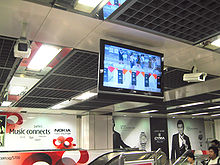 Closed-circuit television cameras monitor activities at City Hall MRT Station. Real-time video feed is broadcast and shown at the station concourse.
Closed-circuit television cameras monitor activities at City Hall MRT Station. Real-time video feed is broadcast and shown at the station concourse.
Security concerns related to crime and terrorism were not high on the agenda of the system's planners at its original inception.[89] However, in the wake of heightened security concerns after the Madrid train bombings in 2004 and the foiled plot to bomb the Yishun MRT Station,[90] the operators deployed private, unarmed guards to patrol station platforms and check the belongings of commuters.[91]
Recorded announcements are frequently made to remind passengers to report suspicious activity and not to leave their belongings unattended. Digital closed-circuit cameras (CCTVs) have been upgraded with recording-capability at all stations and trains operated by SMRT Corporation.[92][93] Trash bins and mail boxes have been removed from station platforms and concourse levels to station entrances. This is to eliminate the risk that bombs will be placed in them.[94] Photography without prior permission was also banned in all MRT stations since the Madrid bombings, but it was not in the official statement in any public transport security reviews.[95]
On 14 April 2005, the Singapore Police Force announced plans to step up rail security by establishing a specialised Police MRT Unit.[96] These armed officers began overt patrols on the MRT and LRT systems on 15 August 2005, conducting random patrols in pairs in and around rail stations and within trains.[97] They are trained and authorised to use their firearms at their discretion, including deadly force if deemed necessary.[98] On 8 January 2006, a major civil exercise involving over 2,000 personnel from 22 government agencies, codenamed Exercise Northstar V, simulating bombing and chemical attacks at Dhoby Ghaut, Toa Payoh, Raffles Place and Marina Bay MRT stations was conducted. Thirteen stations were closed and about 3,400 commuters were affected during the three-hour duration of the exercise.[99]
Security concerns were brought up by the public when two incidents of vandalism at train depots occurred within two years.[100] In both incidents, graffiti on the incident trains were discovered after they entered revenue service.[101] The first incident on 17 May 2010 involved a breach in the perimeter fence of Changi Depot and resulted in the imprisonment and caning of a Swiss foreigner and an Interpol arrest warrant for another accomplice.[102][103] SMRT Corporation received a S$50,000 fine by the Land Transport Authority for the first security breach.[103] Measures were put in place by the Public Transport Security Committee to enhance depot security in light of the first incident, however works were yet to be completed by SMRT Corporation when the second incident on 17 August 2011 occurred at Bishan Depot.[100][101]
See also
- Light Rail Transit
- List of metro systems
- List of Singapore MRT stations
- Murals in Singapore
- Transport in Singapore
Notes
- ^ "The Great MRT Crush". The Straits Times. 13 November 2011.
- ^ "Public Transport Ridership" (PDF). Land Transport Authority. http://www.lta.gov.sg/corp_info/doc/PT%20Ridership%20(2010-cy).pdf. Retrieved 2011-10-20.
- ^ "Singapore MRT". Explore Singapore's "MRTpedia". http://www.exploresg.com/mrt/pedia/. Retrieved 18 April 2010.
- ^ Land Transport Authority, Singapore 1996, pg. 8
- ^ "Train, bus runs". The Straits Times. 24 December 2007.
- ^ Sharp 2005, pg. 66
- ^ Fwa Tien Fang (4 September 2004) (PDF). Sustainable Urban Transportation Planning and Development — Issues and Challenges for Singapore. Department of Civil Engineering, National University of Singapore. http://soc2apc.wikispaces.com/file/view/Issues+and+challenges+for+Singapore,+sustainable+transport+planning+and+development.pdf. Retrieved 2008-12-18.[dead link]
- ^ a b "1982 - The Year Work Began". Land Transport Authority. http://www.lta.gov.sg/public_transport/pt_rail_tracing.htm. Retrieved 2005-12-07.
- ^ Lee Siew Hoon & Chandra Mohan. "In Memoriam - Ong Teng Cheong : A Profile". Channel NewsAsia. http://www.channelnewsasia.com/cna/obituaries/ongtengcheong/special2.htm. Retrieved 2007-11-26.
- ^ a b Mass Rapid Transit Corporation, Singapore 1988, pg. 8-9
- ^ Mass Rapid Transit Corporation, Singapore 1988, pg. 10
- ^ Sharp 2005, pg. 109
- ^ Sharp 2005, pg. 110
- ^ a b Leong Chan Teik (11 February 1996). "Bukit Panjang to get S'pore's first light rail train". The Straits Times. p. 1.
- ^ Sharp 2005, pg. 122
- ^ Karamjit Kaur (26 July 1999). "Bukit Panjang LRT to begin operating on Nov 6". The Straits Times. p. 3.
- ^ Karamjit Kaur (9 February 2002). "Next stop: Changi Airport; New MRT station at airport opens. With wider fare gates and a futuristic design, it promises to be a hit with commuters". The Straits Times.
- ^ Hasnita A Majid (28 August 2005). "Residents bring up 'white elephant' Buangkok MRT during minister's visit". Channel NewsAsia. Archived from the original on 5 February 2008. http://web.archive.org/web/20080205055752/http://www.channelnewsasia.com/stories/singaporelocalnews/view/165384/1/.html.
- ^ Yvonne Cheong (12 November 2005). "Grassroots leaders plan celebration for Buangkok MRT station opening". Channel NewsAsia. Archived from the original on 2 February 2008. http://web.archive.org/web/20080202003214/http://www.channelnewsasia.com/stories/singaporelocalnews/view/178318/1/.html.
- ^ Yeo Ghim Lay & Goh Yi Han (28 February 2009). "Boon for Boon Lay". The Straits Times. http://www.straitstimes.com/Breaking%2BNews/Singapore/Story/STIStory_344108.html.
- ^ Cheryl Lim (21 February 2009). "Boon Lay MRT extension offers shorter journey times". Channel NewsAsia. http://www.channelnewsasia.com/stories/singaporelocalnews/view/410603/1/.html.
- ^ a b Mass Rapid Transit Corporation, Singapore 1988, pg. 14
- ^ "Civil Defence Shelter Programme". Singapore Civil Defence Force. Archived from the original on December 30, 2006. http://web.archive.org/web/20061230165753/http://www.scdf.gov.sg/Building_Professionals/CD_Shelter/shelter_programme.html. Retrieved 2007-01-01.
- ^ a b c Kwan Cheng Fai (April 1987). "Architecture of Singapore MRT Underground Stations Concept Layout and Planning". MRTC & IES 1987, pg. 29-33.
- ^ Eoin Licken (1 July 1999). "New Frontier for Mobile-Phone Operators Lies Underground". International Herald Tribune. http://www.iht.com/articles/1999/07/01/ttmetro.2.t.php.
- ^ Pang Kia Seng, Michael T W Grant, Tom Curley & Scott Danielson (April 1987). "Architectural Aspects of Singapore's Mass Rapid Transit Elevated Stations". MRTC & IES 1987, pg. 13-27.
- ^ Geraldine Yeo (8 February 1996). "MRT shops: What works and why". The Straits Times. p. 43.
- ^ a b Mass Rapid Transit Corporation, Singapore, Trackline Volume 4 No. 5 (October 1987), "A safe railway for all", pg. 4-5.
- ^ Dr. Ing D Herrmann (April 1987). "Heavy Duty Escalators and Their Special Features for MRT". MRTC & IES 1987, pg. 341-350.
- ^ a b Sharp 2005, pg. 176-179
- ^ Toh Su Fen (Land Transport Authority) (2 July 1998). "Public transport can't cater to all disabled". The Straits Times Forum. Archived from the original on 25 September 2006. http://web.archive.org/web/20060925084031/http://www.dpa.org.sg/news/news_july_1998-1.htm.
- ^ Asha Popatlal (12 March 2004). "Tactile tiles to help blind navigate Singapore's MRT stations". Channel NewsAsia. Archived from the original on 17 March 2004. http://web.archive.org/web/20040317071531/http://www.channelnewsasia.com/stories/singaporelocalnews/view/75146/1/.html.
- ^ Land Transport Authority et al., Journeys Issue 42 (Jan/Feb 2003), "Get a Lift-up!", pg. 10.
- ^ Mass Rapid Transit Corporation, Singapore 1988, pg. 46
- ^ B B Broms & J N Shirlaw (April 1987). "Depot Sites". MRTC & IES 1987, pg. 71-77.
- ^ a b "Room to develop at new Circle MRT Line depot". The Straits Times. 28 October 2003.
- ^ Audrey Teo-Loh & Patrick de Labrusse (April 1987). "Orchard Station Architectural Works". MRTC & IES 1987, pg. 53-63.
- ^ Khaw Boon Wan (6 June 2003). "Speech at Launch of Art In Transit". Ministry of Information, Communications and the Arts. Archived from the original on 29 November 2007. http://web.archive.org/web/20071129221707/http://www.mica.gov.sg/pressroom/press_030606.html.
- ^ Naidu Ratnala Thulaja. "Woodlands MRT Station". National Library Board Infopedia. http://infopedia.nl.sg/articles/SIP_366_2005-01-10.html. Retrieved 2007-11-26.
- ^ "Art in Transit brochure" (PDF). Land Transport Authority. http://www.lta.gov.sg/public_transport/doc/Art%20in%20Transit%20brochure.pdf. Retrieved 2005-12-07.
- ^ Adeline Chia (21 August 2008). "Draw the Line; Stop and look before you go as the new $6.7-billion MRT line will be a charmed circle of art and design". The Straits Times Life!.
- ^ Karamjit Kaur (11 February 1998). "Changi Airport MRT station designed for travellers". The Straits Times. p. 1.
- ^ "EXPO Station, Singapore, 1997-2000". Foster and Partners. http://www.fosterandpartners.com/Projects/0966/Default.aspx. Retrieved 2007-09-20.
- ^ a b Land Transport Authority, Singapore 1996, pg. 44-47
- ^ "Other Rail Projects". Land Transport Authority. http://www.lta.gov.sg/projects/index_proj_rail.htm. Retrieved 2005-12-07.
- ^ a b c d e f "Speech by Mr Raymond Lim, Minister for Transport, at the Visit to Kim Chuan Depot, 25 January 2008, 9.00am" (PDF). Singapore Government Media Release. 25 January 2008. http://www.lta.gov.sg/corp_info/doc/250108.pdf.
- ^ "2 new MRT lines & 2 extensions by 2020". The Straits Times. 2008-01-25. Archived from the original on 2008-01-28. http://web.archive.org/web/20080128072925/http://www.straitstimes.com/Latest+News/Singapore/STIStory_199957.html.
- ^ Christoper Tan (13 March 2006). "Groundwork begins for new MRT lines". The Straits Times.
- ^ Asha Popatlal (5 November 2006). "MRT feasibility studies underway for Downtown Line". Channel NewsAsia. Archived from the original on 5 February 2008. http://web.archive.org/web/20080205171934/http://www.channelnewsasia.com/stories/singaporelocalnews/view/239554/1/.html.
- ^ Dominique Loh (27 April 2007). "Govt approves S$12b MRT Downtown Line to be built by 2018". Channel NewsAsia. http://www.channelnewsasia.com/stories/singaporelocalnews/view/272864/1/.html.
- ^ Christoper Tan (28 April 2007). "33-station Downtown Line gets go-ahead, will be ready by 2018". The Straits Times.
- ^ Imelda Saad (15 July 2008). "Downtown Line Stage 2 to have 12 stations". Channel NewsAsia. http://www.channelnewsasia.com/stories/singaporelocalnews/view/360422/1/.html.
- ^ a b Maria Almenoar (26 January 2008). "Two new MRT lines by 2020". The Straits Times. http://www.straitstimes.com/Free/Story/STIStory_200093.html.
- ^ a b c Mass Rapid Transit Corporation, Singapore 1988, pg. 15
- ^ "Train and System Information (Trains)" (Archive). SMRT Corporation. Archived from the original on 2001-04-01. http://web.archive.org/web/20010401005819/www.smrt.com.sg/smrt/train_sys.htm#trains. Retrieved 2007-01-02.
- ^ a b I J Mortimer & M Ishizuka (April 1987). "Mechanical Features of Singapore MRT Rolling Stock". MRTC & IES 1987, pg. 411-419.
- ^ a b "Hyogo Works History". Kawasaki Heavy Industries. Archived from the original on 2005-11-18. http://web.archive.org/web/20051118155122/http://www.khi.co.jp/sharyo/since_final/since_e.html. Retrieved 2006-03-19.
- ^ Chris Sherwell (12 April 1984). "Kawasaki wins major Singapore metro contract". The Financial Times. p. 1.
- ^ Ching Li Tor (4 May 2005). "Fair grounds for fare hikes?". Today.
- ^ T. Rajan (5 November 2006). "MRT trains get $145m overhaul". The Straits Times.
- ^ "References - Metro System, MRTC, Six-Car Units, Singapore". Siemens AG. http://references.transportation.siemens.com/refdb/showReference.do?r=455&div=5&l=en. Retrieved 2005-12-07.
- ^ "Improved MRT train for a better ride arrives". The Straits Times. 21 September 1994. p. 3.
- ^ "Soon, a shorter wait for MRT trains". The Straits Times. 9 May 2000.
- ^ "Commencement of revenue service at Changi Airport Station" (PDF) (Press release). SMRT Corporation. 6 February 2002. http://www.smrt.com.sg/Upload/200712202113259920.pdf.
- ^ Karamjit Kaur & Shahida Ariff (24 April 2002). "MRT slow-down as trains are taken off for checks; SMRT pulls out 21 trains after detecting gear fault; longer wait for commuters, direct service to Changi Airport affected". The Straits Times.
- ^ "Board MRT to airport from Tanah Merah". The Straits Times. 18 July 2003.
- ^ "LTA awards $368m train supply job". The Business Times (Singapore). 7 May 2009.
- ^ a b Karamjit Kaur (20 November 2002). "Driverless MRT trains on new line will be safe; The North-East MRT line will have safety features like CCTVs and smoke detectors to protect commuters, says LTA". The Straits Times.
- ^ Land Transport Authority et al., Journeys Issue 42 (Jan/Feb 2003), "Safe, Sound and Fully Automated", pg. 8–9.
- ^ Xavier Champaud (24 October 2005) (PDF). CCL - The Longest Automatic Metro Line In The World. IRSE Technical Convention, Singapore: Institution of Railway Signal Engineers, Singapore. pp. 6. http://www.irse.org.sg/reference_documents/Convention%20Papers/IRSE%20Paper%2012%20-%20X%20Champaud.pdf. Retrieved 2008-12-18.
- ^ Christopher Tan (8 November 2008). "Downtown train deal goes to Bombardier". The Straits Times.
- ^ R C Longden & E W Finch (April 1987). "Automatic Fare Collection - Serving the Commuter". MRTC & IES 1987, pg. 319-324.
- ^ a b c Sharp 2005, pg. 113-115
- ^ a b Land Transport Authority, Singapore 1996, pg. 58-59
- ^ "Tricky balance in fare changes". The Straits Times Editorial. 17 September 2007.
- ^ Yvonne Cheong (14 April 2005). "Public transport fare hike not justified as SMRT still profitable: CASE". Channel NewsAsia. Archived from the original on 2 February 2008. http://web.archive.org/web/20080202003159/http://www.channelnewsasia.com/stories/singaporelocalnews/view/145571/1/.html.
- ^ Christopher Tan (13 September 2008). "Bus and MRT fares to go up from Oct 1; But 4 in 10 commuters to pay the same or less; transfers to cost less". The Straits Times.
- ^ "New NEL Fare Structure Approved" (PDF) (Press release). Public Transport Council. 8 May 2003. http://www.ptc.gov.sg/news4.pdf.
- ^ a b Maria Almenoar (9 January 2009). "Free replacement exercise on till Sept 30". The Straits Times. http://www.straitstimes.com/print/Breaking%2BNews/Singapore/Story/STIStory_323895.html. Retrieved 2009-07-20.[dead link]
- ^ Imelda Saad (26 August 2008). "New e-payment system and next generation card for public transport". Channel NewsAsia. http://www.channelnewsasia.com/stories/singaporelocalnews/view/371754/1/.html.
- ^ Maria Almenoar (13 December 2007). "New unlimited travel pass for visitors; A one-day pass for buses and trains will cost $18 with $10 refundable; also available: two-day and three-day versions". The Straits Times.
- ^ Tammy Tan (SBS Transit) (24 December 2005). "Measures in place to ensure safe ride on NEL". The Straits Times Forum.
- ^ Y C Siew & J P Copsey (April 1987). "Singapore Mass Rapid Transit System Design for Fire and Emergency". MRTC & IES 1987, pg. 131-139.
- ^ "Rapid Transit Systems Act (Chapter 263A, Section 42)". Singapore Statutes Online. http://statutes.agc.gov.sg/non_version/cgi-bin/cgi_retrieve.pl?actno=REVED-263A&doctitle=RAPID%20TRANSIT%20SYSTEMS%20ACT%0a&date=latest&method=part. Retrieved 2005-12-07.
- ^ "Fined $30 for eating sweet". The Straits Times. 17 July 2009. http://www.straitstimes.com/Breaking+News/Singapore/Story/STIStory_404559.html. Retrieved 2009-07-20.[dead link]
- ^ Matthew Pereira & Branden Pereira (6 August 1993). "MRT Trains collide at Clementi : 132 hurt". The Straits Times. pp. 1 & 25.
- ^ "Safety at MRT and LRT Stations - Respect The Yellow Line" (Press release). Land Transport Authority. 20 November 2005. http://app.lta.gov.sg/corp_press_content.asp?start=1090.
- ^ Yeo Ghim Lay (3 September 2008). "Platform doors for elevated MRT stations". The Straits Times.
- ^ López, M.J.J. (1996), Den Haag: RCM-advies, "Crime Prevention Guidelines for the Construction & Management of Metro Systems", pg. 35–39.
- ^ "The Link of the Yishun Videotape" (Press release). Minister for Home Affairs (Singapore). 24 January 2002. http://www.channelnewsasia.com/cna/arrests/release1_020124.htm.
- ^ Goh Chin Lian (1 June 2004). "Security guards start MRT patrols". The Straits Times.
- ^ Johnson Choo (7 August 2004). "CCTVs at 35 elevated MRT stations to have recording capability by Oct 2004" (Archive). Channel NewsAsia. Archived from the original on 8 March 2005. http://web.archive.org/web/20050308003901/http://www.channelnewsasia.com/stories/singaporelocalnews/view/99715/1/.html.
- ^ Goh Chin Lian (6 June 2006). "Buses, trains get security cameras". The Straits Times.
- ^ Goh Chin Lian (13 May 2005). "Postboxes moved out of MRT, LRT stations". The Straits Times.
- ^ Karen Chow (SMRT Corporation) (4 September 2007). "Why no photos at MRT stations...". The Straits Times Forum.
- ^ Dominique Loh (2 May 2005). "MRT stations to have armed police officers on patrol". Channel NewsAsia. Archived from the original on 2 February 2008. http://web.archive.org/web/20080202003154/http://www.channelnewsasia.com/stories/singaporelocalnews/view/142602/1/.html.
- ^ Khushwant Singh Asad Latif (16 August 2005). "Armed police patrol trains; Another layer of security; men trained to handle suspicious objects and people". The Straits Times.
- ^ Johnson Choo (15 August 2005). "Special armed police unit begins MRT patrols". Channel NewsAsia. Archived from the original on 2 February 2008. http://web.archive.org/web/20080202003209/http://www.channelnewsasia.com/stories/singaporelocalnews/view/163270/1/.html.
- ^ "Singapore holds largest-ever terror attack response drill". Channel NewsAsia. 8 January 2006. Archived from the original on 5 February 2008. http://web.archive.org/web/20080205104219/http://www.channelnewsasia.com/stories/singaporelocalnews/view/187113/1/.html.
- ^ a b Joy Fang (19 August 2011). "MRT graffiti read: 'Jet Setter's'". my paper. http://news.asiaone.com/News/AsiaOne%2BNews/Singapore/Story/A1Story20110819-295140.html.
- ^ a b "MRT train vandalised at Bishan depot". AsiaOne. 17 August 2011. http://www.asiaone.com/News/AsiaOne+News/Singapore/Story/A1Story20110817-294968.html.
- ^ Imelda Saad (8 June 2010). "SMRT says staff mistook graffiti on train for advert". Channel NewsAsia. http://www.channelnewsasia.com/stories/singaporelocalnews/view/1061853/1/.html.
- ^ a b Evelyn Choo (14 February 2011). "SMRT given maximum fine". Channel NewsAsia. http://www.channelnewsasia.com/stories/singaporelocalnews/view/1110605/1/.html.
References
Academic publications
- Sock, Y.P. and Walder, Jay H. (1999). Singapore’s Public Transport.
Corporate and governmental sources
- Sharp, Ilsa (2005). The Journey - Singapore's Land Transport Story. SNP:Editions. ISBN 981-248-101-X.
- Land Transport Authority, Singapore (2 January 1996). A World Class Land Transport System - White Paper presented to Parliament. ISBN 9971-88-488-7.
- Mass Rapid Transit Corporation, Singapore (1993). Stored Value - A Decade of the MRTC. ISBN 981-00-5034-8.
- Mass Rapid Transit Corporation, Singapore (1988). The MRT Story. ISBN 981-00-0251-3.
- Singapore MRT Limited (1987). MRT Guide Book. ISBN 981-00-0150-9.
- Mass Rapid Transit Corporation (MRTC) and Institution of Engineers Singapore (IES) (1987). Mass Rapid Transit System : Proceedings of the Singapore Mass Rapid Transit Conference, Singapore 6–9 April 1987. ISBN 9971-84-636-5.
External links
Listen to this article (info/dl)
This audio file was created from a revision of Mass Rapid Transit (Singapore) dated 2007-05-14, and does not reflect subsequent edits to the article. (Audio help)More spoken articles- SMRT Corporation Official Site
- SBS Transit Official Site
- Official System map (including lines under construction), Land Transport Authority
- UrbanRail Singapore
- Singapore's Rail Transit System
- How to ride MRT in Singapore
- Network map
Mass Rapid Transit (Singapore) 
Overviews History (Nicoll Highway collapse) · Stations · Fares and ticketing · Facilities (STARIS) · Safety · Security (Public Transport Security Command)
Lines CurrentUnder ConstructionFutureDefunctRolling stock Kawasaki C151 · Siemens C651 · Kawasaki/Nippon Sharyo C751B · Alstom Metropolis C751A · Alstom Metropolis C830 · Kawasaki C151A · Bombardier MOVIA C951Depots Companies Railway lines in Singapore Mass Rapid Transit (MRT) North South (SMRT) · East West (SMRT) · North East (SBST) · Circle (SMRT) · Downtown (SBST) · Thomson · Eastern Region
Light Rail Transit (LRT) International Other lines Changi Airport Skytrain (CAAS) · Jurong BirdPark Panorail (WRS) · Sentosa Express (SDC) · Sentosa Monorail (defunct) (SDC)
Categories:- Mass Rapid Transit (Singapore) stations
- Mass Rapid Transit (Singapore)
- Rail transport in Singapore
- Underground rapid transit systems
Wikimedia Foundation. 2010.

